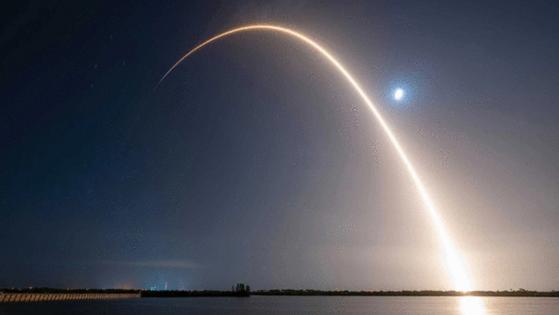SpaceX targets nighttime launch of competitor Amazon's satellites
Published in Science & Technology News
ORLANDO, Fla. – SpaceX is set to finish up its third of three contracted launches of competitor Amazon’s Project Kuiper satellites on Thursday night.
A Falcon 9 on the KF-3 mission to launch 24 more of Amazon’s broadband internet satellites is set to lift off from Kennedy Space Center Launch Pad 39-A targeting 9:34 p.m. Eastern time during a launch window that runs from 9:24 p.m.- 11:58 p.m.
The first-stage booster is flying for the second time and will aim for a recovery landing on the droneship Just Read the Instructions stationed in the Atlantic.
It would mark the 85th orbital launch from all providers on the Space Coast in 2025 with all but five coming from SpaceX.
Including this mission, six of those have been for Amazon with three on SpaceX Falcon 9 rockets and three on United Launch Alliance Atlas V rockets.
With this batch, Amazon’s satellite total will climb to 153. That’s out of a planned 3,236 total needed to be in orbit by July 2029, half of which are supposed to be launched by July 2026, according to a license issued by the Federal Communications Commission.
That license was issued back in 2020, and Amazon followed that up by tapping ULA, Bezos’ Blue Origin and European launch provider Arianespace to fly the lion’s share of its satellites. In what Amazon called the largest procurement of launches at one time ever made, it was leaning on ULA’s Vulcan, Blue Origin’s New Glenn and Arianespace’s Ariane 6, all in-development heavy-lift rockets, to provide up to 83 launches to get its constellation into space.
But all three of those rockets faced delays, and to date, none has launched with Amazon satellites. ULA’s three batches flown on the smaller Atlas V rockets were on top of using one in 2023 with a pair of developmental pathfinder satellites.
ULA has five more Atlas V rockets ready to add another 135 satellites to the constellation. But with a need to get more satellites up sooner, Amazon turned to SpaceX, even though Elon Musk’s company has its own broadband satellite constellation with Starlink.
Starlink already has launched nearly 10,000 of those since 2019, with more than 8,600 still in orbit, according to statistics maintained by astronomer Jonathan McDowell.
Amazon, though, has increased the pace of production for its satellites, manufactured in Washington, and is now utilizing its $140 million satellite processing facility at Kennedy Space Center to prep them for launch.
Except for the Ariane 6, which would launch from South America, all other launches would be from the Space Coast.
ULA expects to get its new Vulcan rocket in the mix this year while Blue Origin’s New Glenn could also join the launch manifest in the next 12 months. It’s unclear when Arianespace would have its first launch to begin to satisfy its contract.
Amazon has 38 Vulcan launches under contract as well as 12 for Blue Origin’s New Glenn with an option to purchase 15 more. Ariane 6 has 18 launches under contract.
The larger Vulcan will be able to fit about 45 of the Project Kuiper satellites, meaning if ULA alone were to try and launch the final 1,330 more needed in the next year, it would take at least 30 launches on top of the five Atlas V launches.
More likely, the FCC will adjust Blue Origin’s requirements now that the company has shown it’s capable of supplying satellites, and just needs more launch providers with available rockets to get them into space.
-------------
©2025 Orlando Sentinel. Visit at orlandosentinel.com. Distributed by Tribune Content Agency, LLC.







Comments